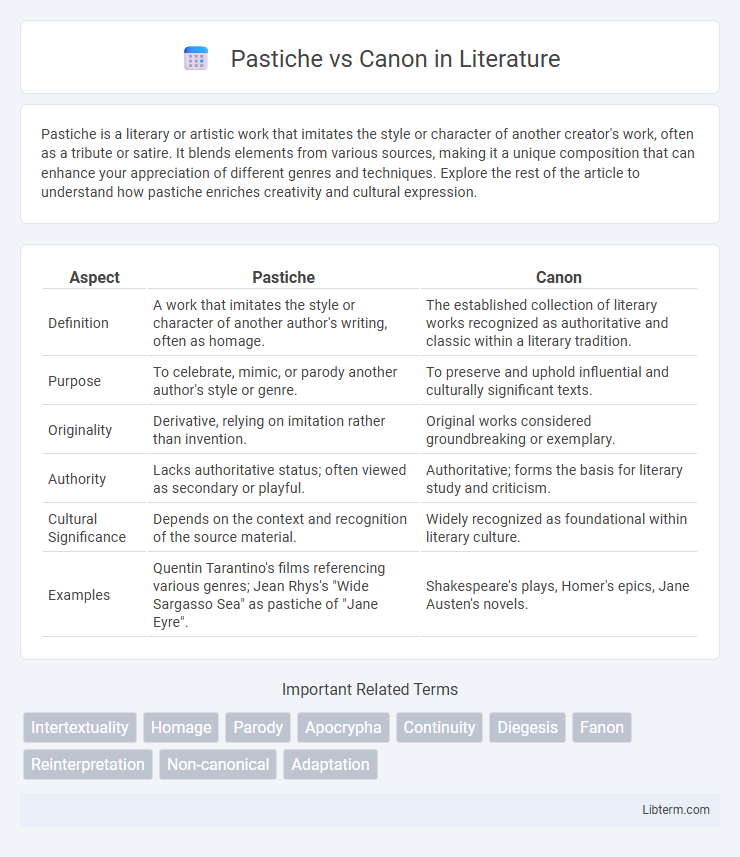Pastiche is a literary or artistic work that imitates the style or character of another creator's work, often as a tribute or satire. It blends elements from various sources, making it a unique composition that can enhance your appreciation of different genres and techniques. Explore the rest of the article to understand how pastiche enriches creativity and cultural expression.
Table of Comparison
| Aspect | Pastiche | Canon |
|---|---|---|
| Definition | A work that imitates the style or character of another author's writing, often as homage. | The established collection of literary works recognized as authoritative and classic within a literary tradition. |
| Purpose | To celebrate, mimic, or parody another author's style or genre. | To preserve and uphold influential and culturally significant texts. |
| Originality | Derivative, relying on imitation rather than invention. | Original works considered groundbreaking or exemplary. |
| Authority | Lacks authoritative status; often viewed as secondary or playful. | Authoritative; forms the basis for literary study and criticism. |
| Cultural Significance | Depends on the context and recognition of the source material. | Widely recognized as foundational within literary culture. |
| Examples | Quentin Tarantino's films referencing various genres; Jean Rhys's "Wide Sargasso Sea" as pastiche of "Jane Eyre". | Shakespeare's plays, Homer's epics, Jane Austen's novels. |
Understanding Pastiche and Canon: Definitions
Pastiche refers to a creative work that imitates the style or character of another artist or period, often celebrating or paying homage without claiming originality. Canon represents the official collection of works considered authentic and authoritative within a particular literary, artistic, or cultural tradition. Distinguishing between pastiche and canon involves recognizing pastiche as derivative and often playful, while canon embodies recognized standards and enduring value.
Historical Origins of Pastiche and Canon
Pastiche originated during the Renaissance as an artistic technique that mimics various styles or works without strict adherence to originality, often blending elements from multiple sources to create a new piece. Canon refers to a set of established works, typically authoritative or classic texts, recognized over time for their cultural, historical, or aesthetic significance, forming a standard for comparison and study. The historical origins of pastiche lie in imitation and playful homage, while the canon evolved through institutionalized validation by critics, scholars, and cultural gatekeepers to define artistic value.
Key Differences Between Pastiche and Canon
Pastiche involves imitating or replicating the style or elements of original works, often blending multiple influences without altering the core narrative or world-building. Canon refers to the officially accepted storyline, characters, and settings established by the original creator or authorized source, serving as the definitive reference for a fictional universe. The key difference lies in pastiche being an external, often non-canonical homage, while canon maintains the authoritative continuity and authenticity of the original work.
The Role of Authorship in Canon and Pastiche
Authorship in canon involves recognized original creators whose works define cultural and literary standards, establishing authoritative texts that shape ongoing interpretations and adaptations. In pastiche, authors actively blend or imitate these canonical styles and themes, emphasizing creative reinterpretation over originality and challenging traditional notions of singular authorship. This dynamic highlights the evolving relationship between originality, influence, and the construction of literary value within established and derivative works.
Literary Examples: Pastiche vs Canon
Pastiche in literature emulates the style or themes of another author's work without claiming originality, as seen in "Wide Sargasso Sea" by Jean Rhys, which reimagines Charlotte Bronte's "Jane Eyre" from a new perspective. Canon refers to works widely accepted as authoritative or classical within literary tradition, such as Shakespeare's "Hamlet," which shapes subsequent interpretations and adaptations. The distinction lies in canon establishing the original benchmark, while pastiche creatively dialogues with that benchmark, often blending homage and critique.
Influence on Reader Perception and Interpretation
Pastiche often shapes reader perception by blending familiar styles and motifs, leading to a layered interpretation that highlights homage or critique of original works. Canon, as an established body of authoritative texts, guides readers toward accepted meanings and interpretations, reinforcing cultural or literary values. The contrast between pastiche and canon influences how readers engage with narrative authenticity, originality, and intertextuality in literature.
Pastiche in Modern Media and Pop Culture
Pastiche in modern media and pop culture functions as an intentional artistic imitation that celebrates and reinterprets original styles or genres without parodying them. It enables creators to blend diverse influences, often reviving nostalgic elements from past media to engage contemporary audiences. This technique enriches storytelling by layering multiple cultural references, thereby fostering a dynamic dialogue between historical and current artistic expressions.
Canon’s Impact on Storytelling and Continuity
Canon shapes storytelling by establishing an authoritative source of truth that guides character development and plot progression, ensuring consistency across narratives. It creates a cohesive universe where events and character actions maintain logical continuity, enhancing audience engagement through reliable world-building. This structured framework helps writers maintain narrative integrity, preventing contradictions and preserving the story's legacy over time.
Critical Debates: Value of Pastiche and Canon in Literature
Pastiche challenges traditional literary canon by blending multiple styles and voices, raising debates on originality and authenticity in literature. Critics argue that pastiche democratizes creativity and reflects cultural hybridity, while defenders of the canon emphasize its role in preserving artistic standards and historical significance. The ongoing critical discourse interrogates whether pastiche dilutes literary value or enriches the canon through intertextual innovation.
Future Trends: Blending Canon and Pastiche
Emerging literary trends demonstrate an increasing blend of pastiche and canon, where creators integrate classic canonical themes with innovative pastiche techniques to revitalize narratives and appeal to diverse audiences. This hybrid approach leverages canonical authority while embracing postmodern intertextuality, enabling dynamic storytelling that respects tradition yet challenges conventions. Future works are expected to further exploit this synergy, fostering a nuanced dialogue between established literary canons and playful reinterpretations.
Pastiche Infographic

 libterm.com
libterm.com